This post may contain affiliate links. Please read our disclosure policy.
How to pick and cut a mango with 4 simple methods (and bonus ways to enjoy mango WITHOUT chopping it). This post will show you how to dice, slice, and gather the fruit using super simple methods. You’ll never struggle to enjoy this tropical fruit again!
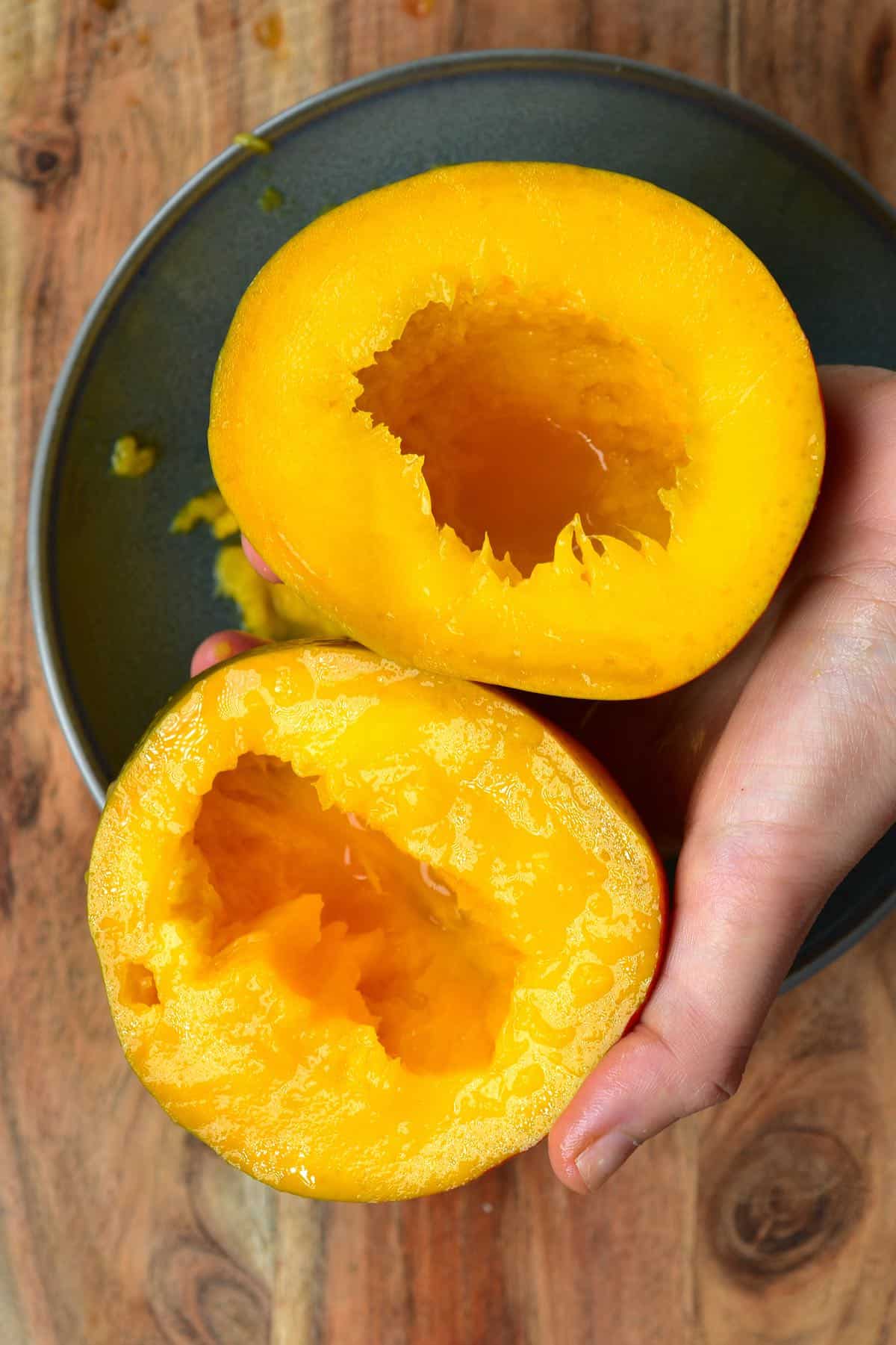
Does this sound familiar to anyone? You’ve finally decided to buy a mango – or may by now it’s your third or fourth attempt, you get it home, and somehow – after quite a lot of hassle, you end up with hacked up pieces of mango, this seed in the middle that seems to get in the way no matter how you cut it? Or was that just me…
Either way, I thought that I’d share this post to help you learn how to cut a mango, step by step (without ending up with a huge mess on your hands). This post shows you several ways to cut a mango – how to chop it into cubes, how to scoop out the mango flesh easily, how to cut mango slices, and others.

For any of these methods, the main thing is to make sure that you have a lovely, juicy, ripe mango. So first, let’s take you through a little ‘how-to’ find a ripe one.
Want to save this recipe?
To Find A Ripe Mango
There are a couple of things you can look for when selecting a ripe mango. It’s important to note that color isn’t actually the best indicator for a ripe mango (because all different varieties can be different colors when ripe). Instead:
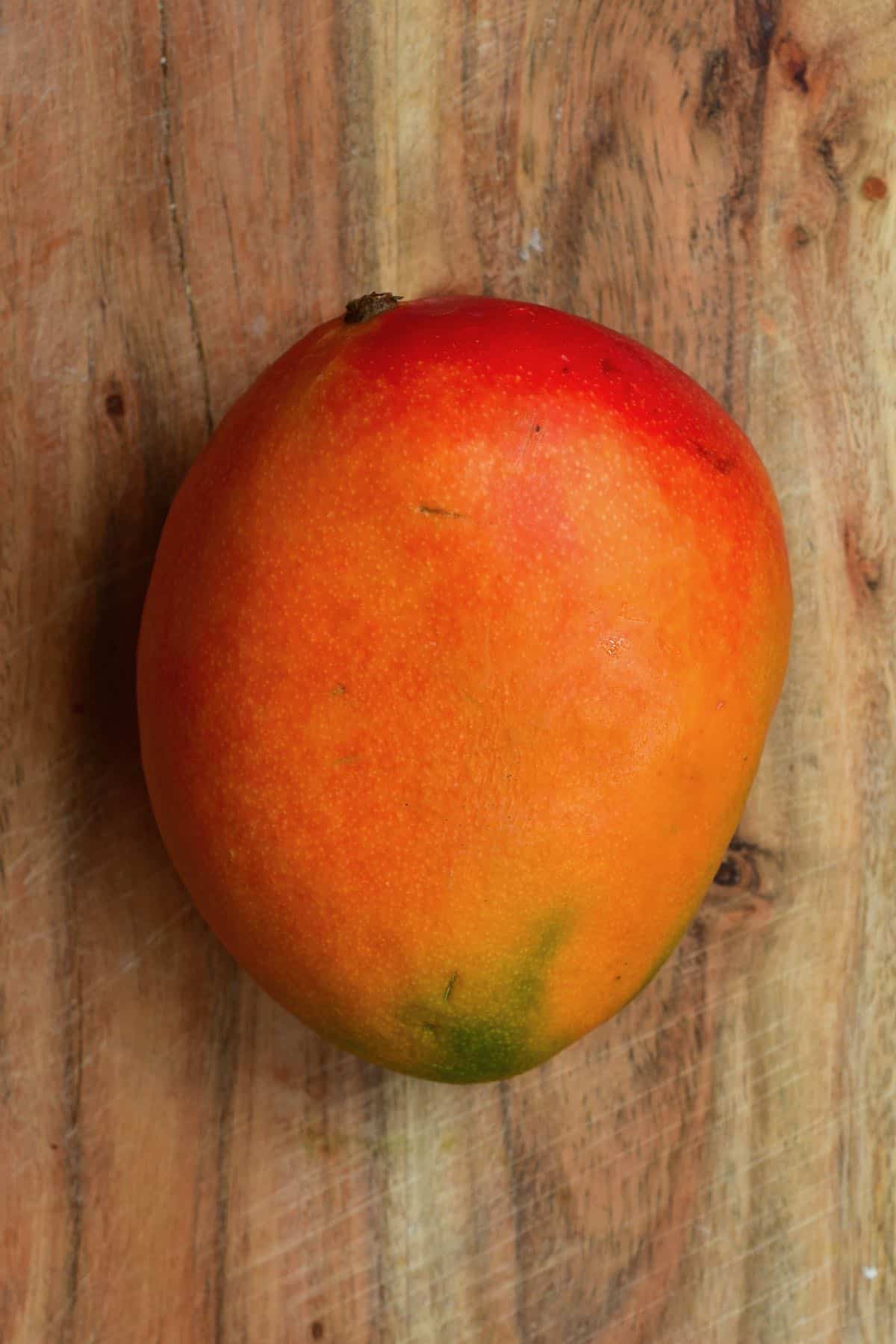
- Squeeze the mango gently – it should have a little give (like a ripe avocado or peach). This means the flesh inside is soft. Too soft and it’s overripe, no give and it’s not ripe enough.
- Smell the mango. Ripe mangos with smell super sweet and fruity near the stem end.
Top Tip: If you do happen to have underripe mango at home, then pop it/them in a paper bag, secure it shut, and wait. Check them every day until ripened – the ethylene gas that comes off the fruit will be secured within the bag and help them to ripen faster.
Once your mangos are ripe and chosen – it’s time to chop them with what I consider the easiest way to cut a mango. I haven’t struggled once since adopting it.
How To Cut Mango
The main difficulty in cutting this fruit is knowing where the pit is and how to avoid it. The pit of a mango is fairly flat, oblong, and is almost as wide as the mango itself. The aim is to chop off the ‘cheeks’ of mango flesh on either side of the pit.
Note* You can peel the mango before slicing for easier and prettier dicing/slicing without losing any flesh. However, the peeled mango is SUPER slippery, making the initial cutting trickier, so I tend to leave it unpeeled.
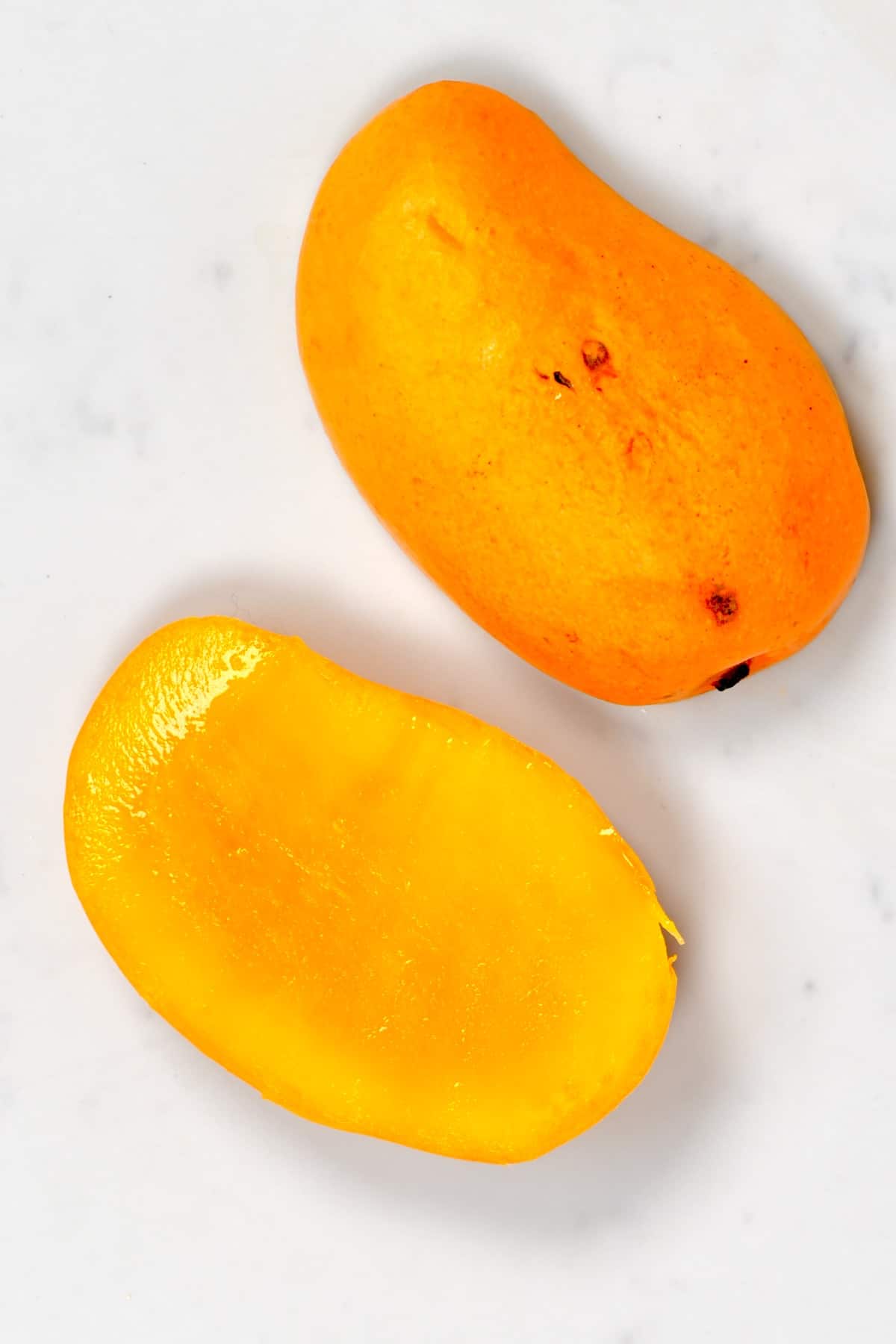
First, Hold the mango with the stem facing up. The narrow, widest part of the mango is the center where the pit is. The rounder, fatter bits on each side are the ‘cheeks.’
Then, Leaving around 1/2-inch from the center of the mango (where the stem is), cut straight down the mango’s length, and then repeat on the other side. At this point, you should have two cheeks, and the middle part containing the pit.
Note* If you happen to touch the pit when cutting, then remove the knife, start a cut a little further away from the center and try again. You’ll soon get used to eyeballing exactly where to cut.
Next, we have three methods of chopping/gathering the mango ‘cheek’ flesh.
Method 1: Diced
This is probably one of the most well-known/traditional methods. To dice mangoes, slice a grid pattern (the lines about 1/2-inch apart) across both mango halves/cheek. Make sure not to cut through the skin.
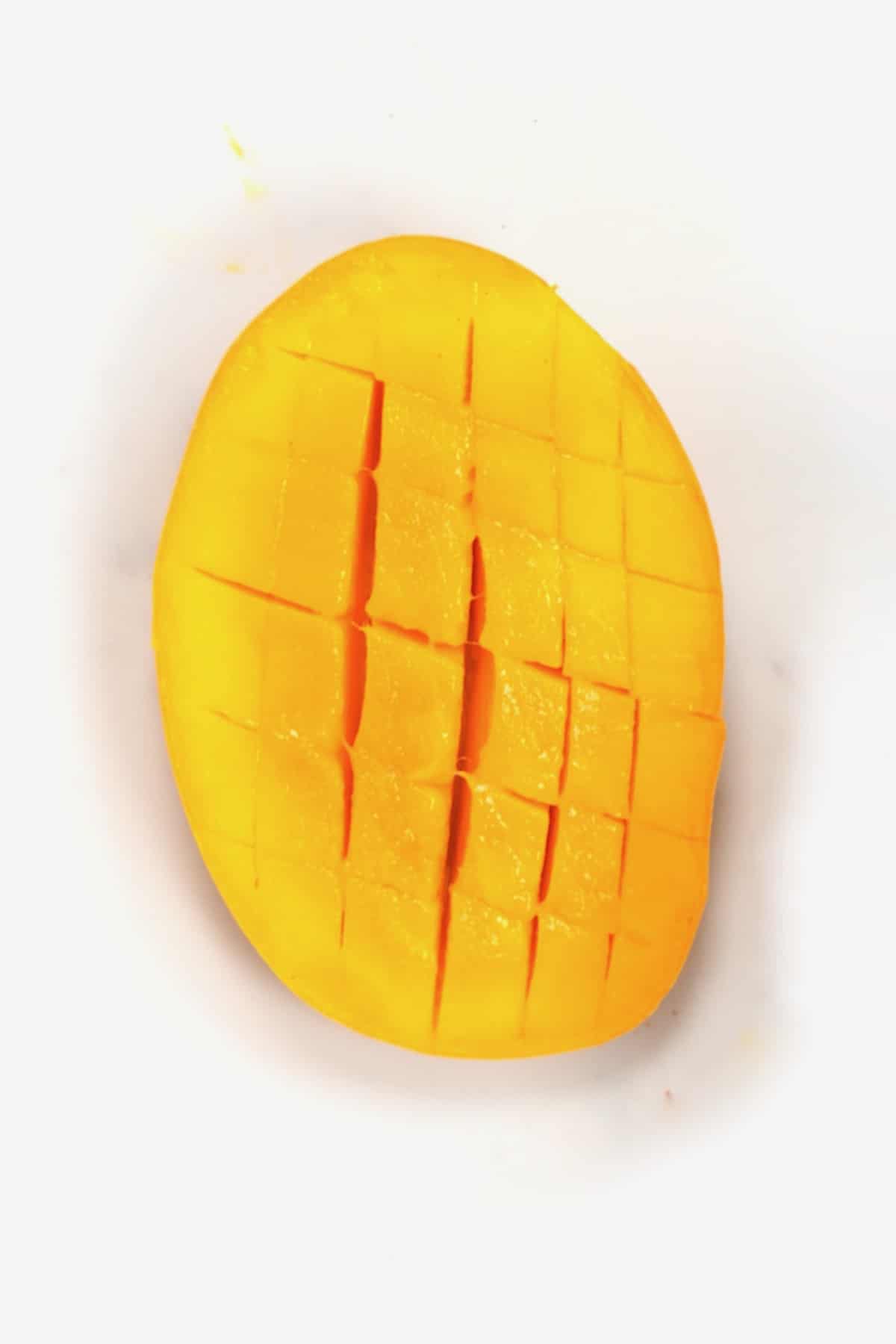
At this point, you can scoop out the flesh with a spoon OR it should be easy to push the skin side and invert the mango so that the cut sections are all sticking out (like a hedgehog).
Use a small paring knife (or mango tool) to cut away the mango from the skin. Don’t worry if you don’t get it all the way to the skin as you can go back with a spoon and peel away all the remaining flesh. Do this to both ‘cheeks’ using the knife and then a spoon to gather as much flesh as possible from the skin.
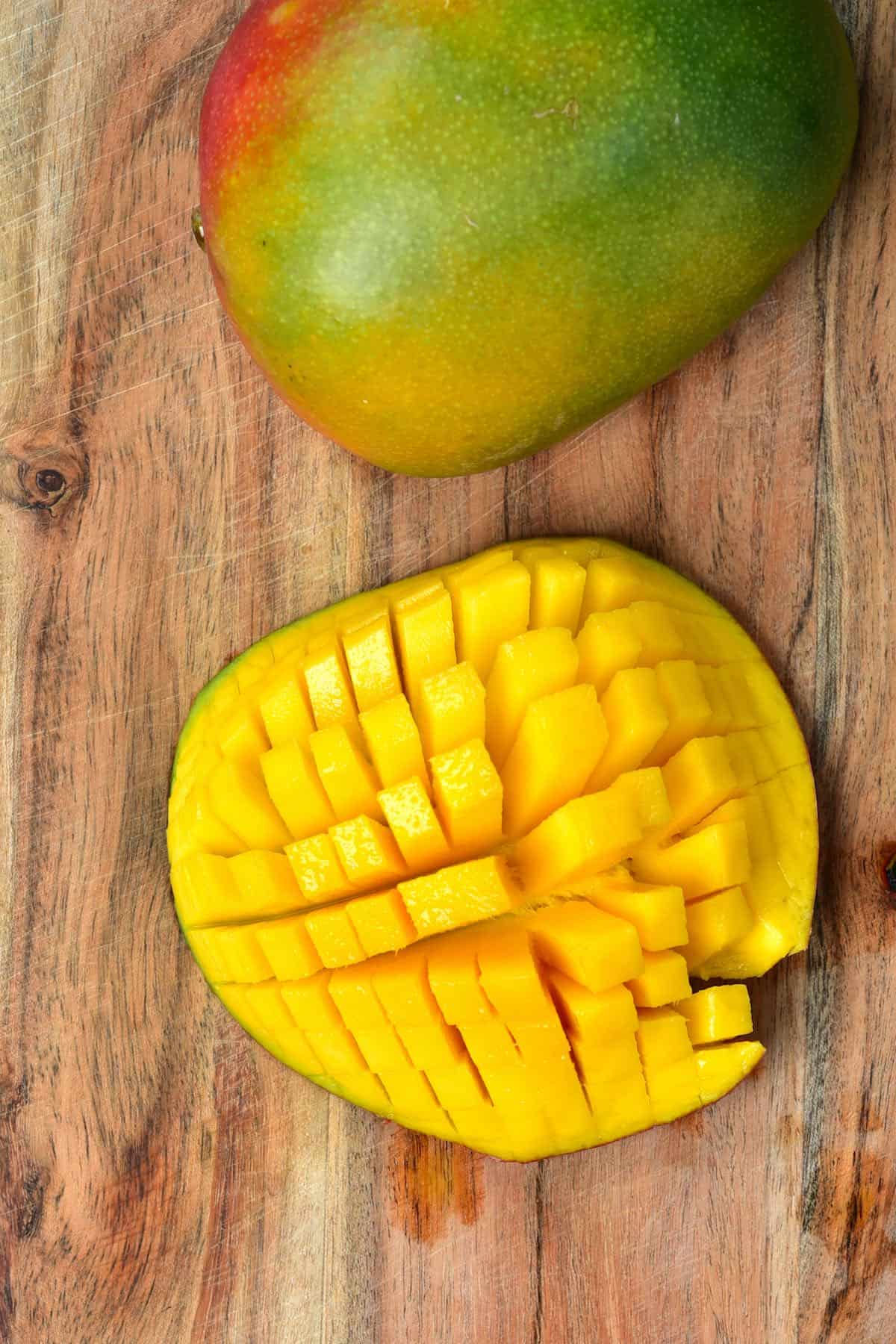
Method 2: The Glass
This method makes peeling a ripe mango SUPER easy. But it’s not for those wanting pretty mango pieces for a recipe. I’ll usually use this method whenever the mango isn’t going to be displayed (like for this Quick Mango Sweet Chili Sauce or Mango Smoothie Bowl).
All you need is your chopped mango cheeks and a pint glass or any cup with fairly thin sides.
Hold the bottom of one of the mango cheeks against the glass rim and slide it downwards to scoop out the flesh. It will drop into the glass, and voila.

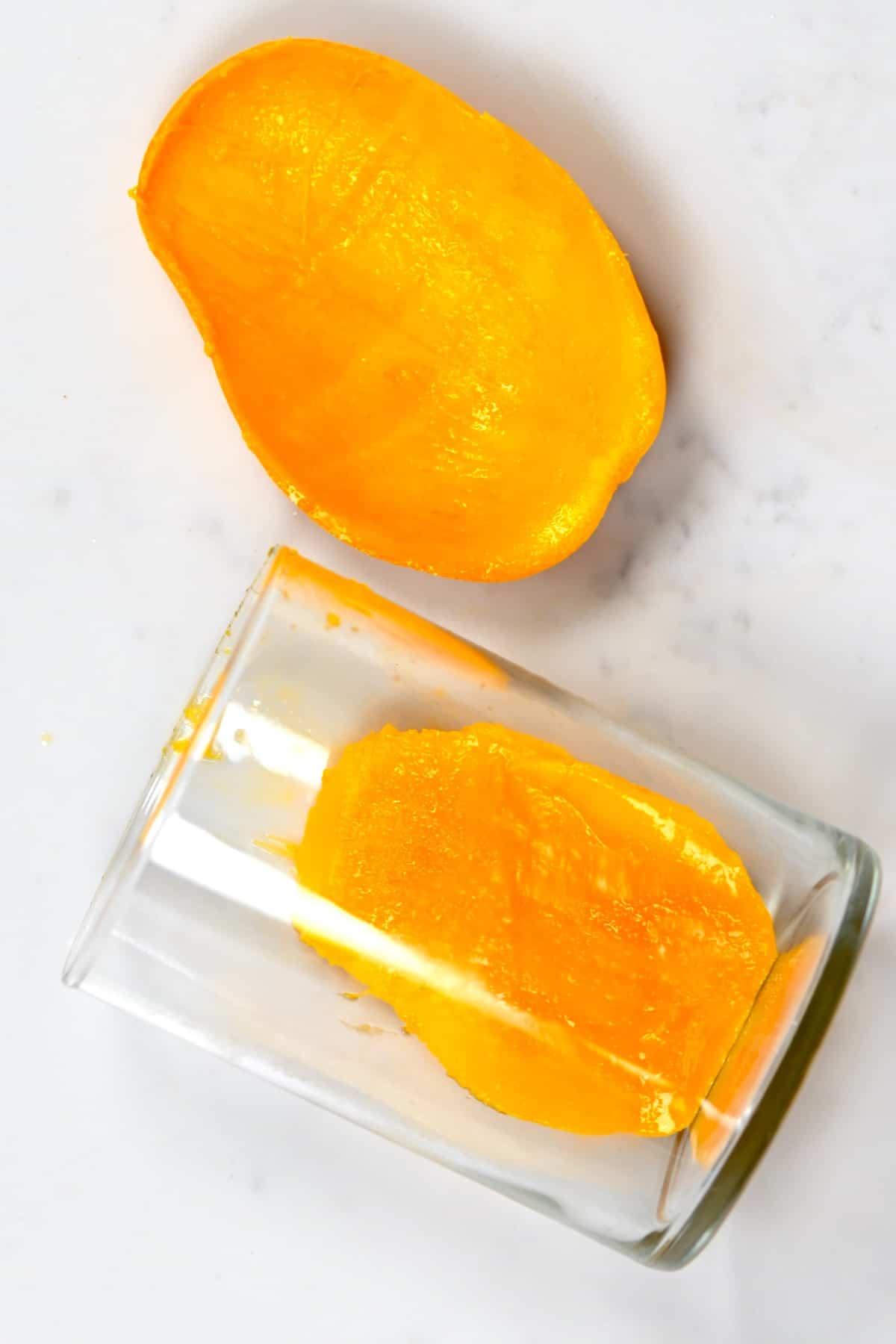
If any flesh is left with the skin, then use a spoon to get it out. Your mango is ready to use.
Note: As a bonus, you’ll sometimes have a little mango juice at the bottom of the glass which you can sip on if it’s not needed in your recipe.
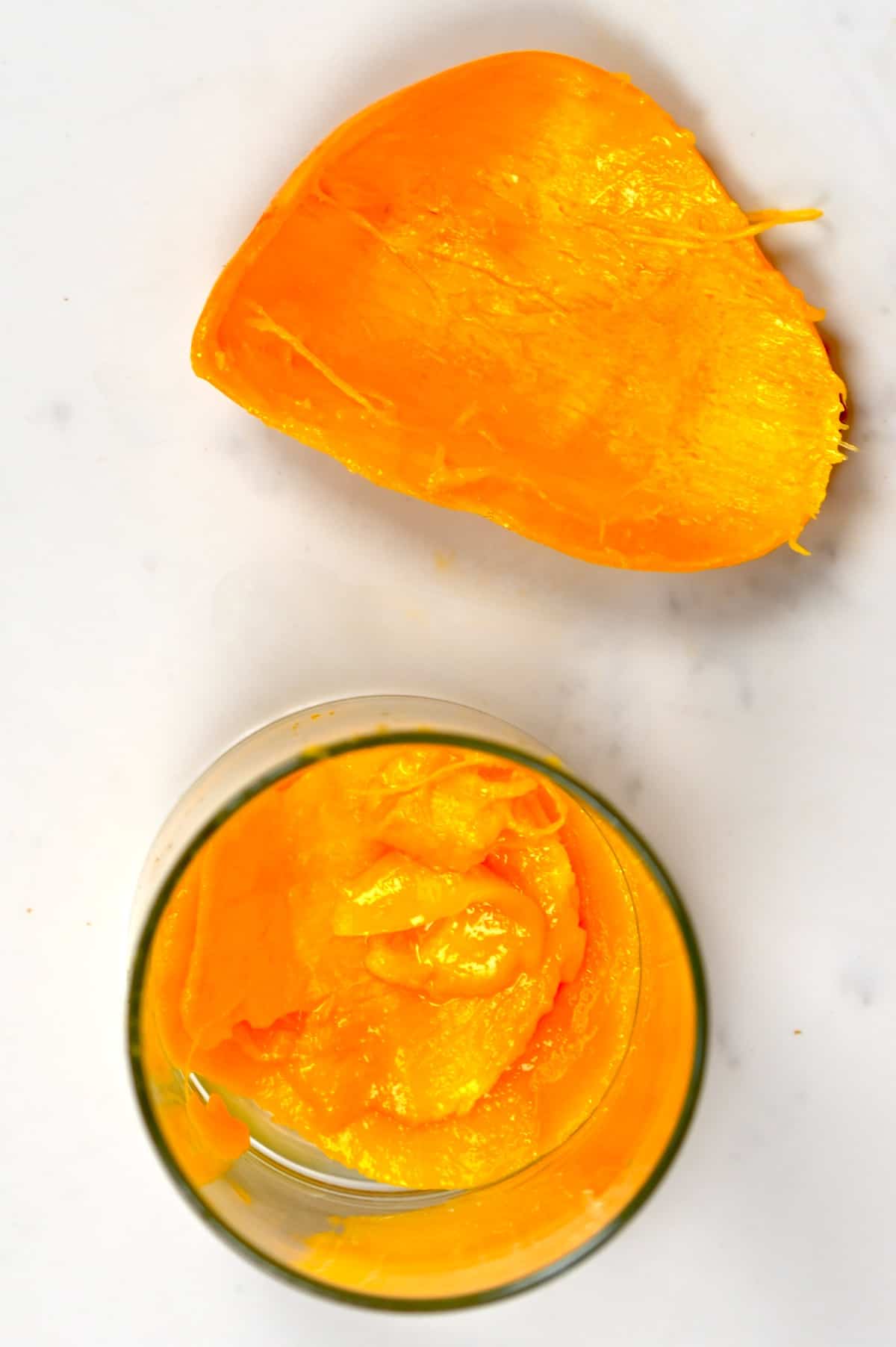
Method 3: To Slice
I kept this as a kind of bonus because it sort of comes under both previous methods. To cut long slices of mango then you have several options.
You could cut them from the flesh removed using the glass method – but the slices won’t be “pretty”. You can also do this with peeled mango (method mentioned below).
Alternative Cutting Methods
Slicing the mango on each side of the pit isn’t the only way to cut it into mango, so here are some alternative methods of enjoying mango.
Method 4: Cut In Half
Like avocado (although people hate the option then, too), you can chop mango by cutting all the way around the center of the mango. When pulling, one half will have the seed in, and the other will be empty.
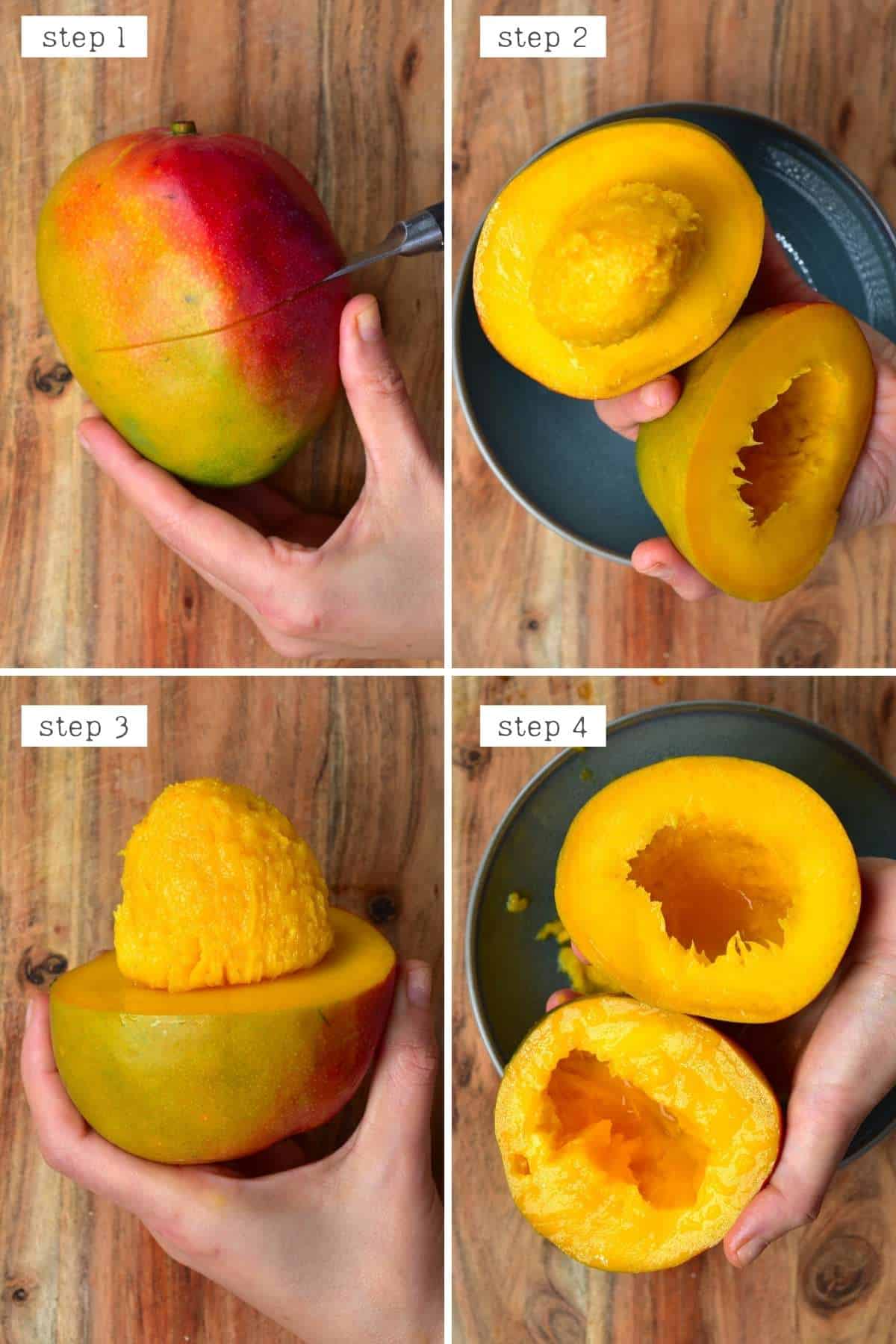
You can then remove the seed from the other half and scoop out the flesh (or even use it as a bowl and fill the hole with yogurt (dairy or vegan – like almond, coconut, or soy) and other fruits and/or granola).
Method 5: Peel The Skin
This is something I usually avoid, as peeled mango is very slippery. However, if you want to cut nice slices from the mango, you can peel it first before chopping the flesh away from the seed.
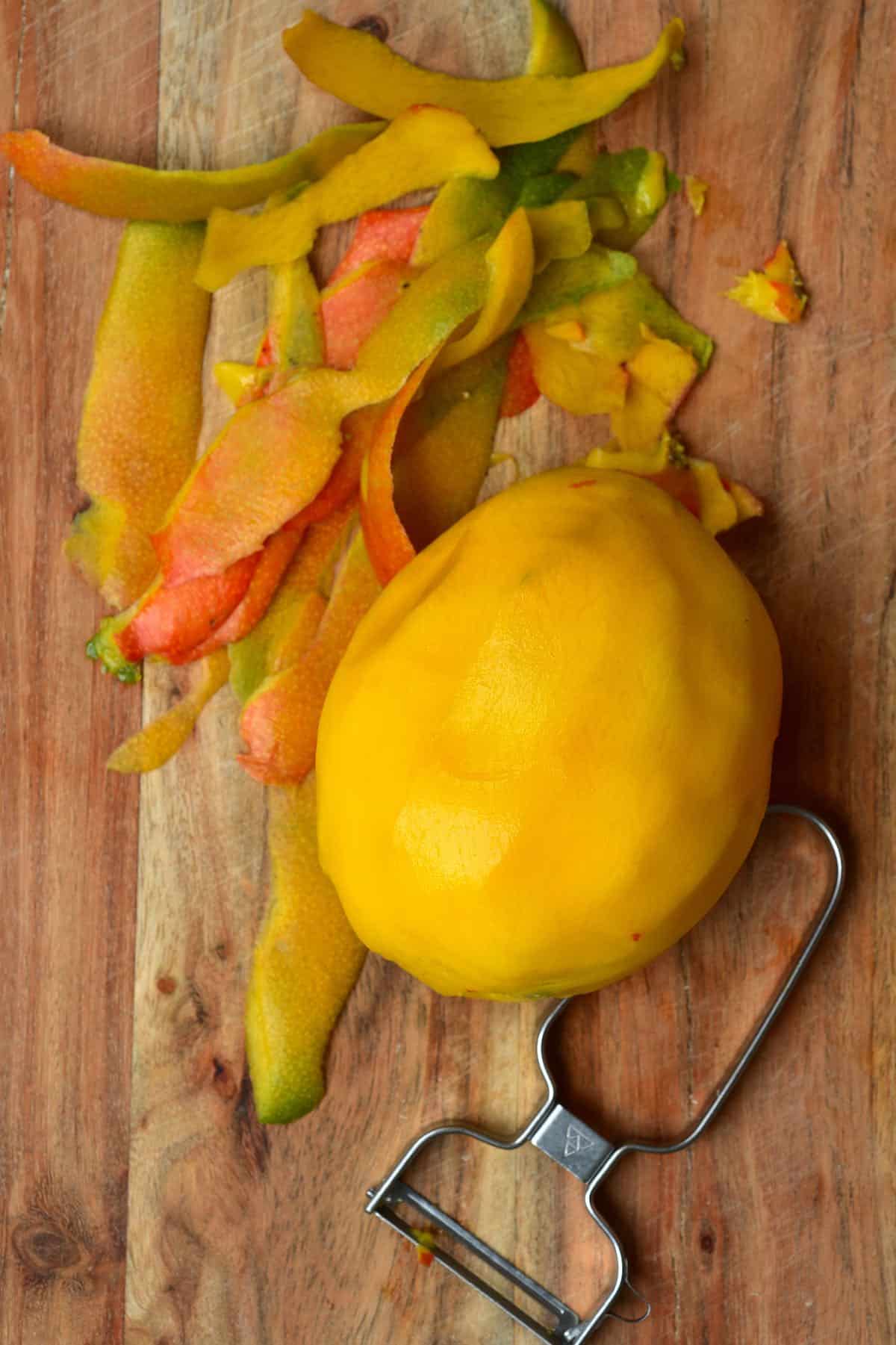
You can peel a mango with a sharp paring knife (hold the stem while doing so), with a vegetable peeler, or by hand (which will only work if the mango is very ripe and soft.
To do this, create an X in the bottom of the mango, and you should be able to pull up the sections and gently pull to remove the skin. You can also do this from the stem end.
To Enjoy Mango Without Cutting it
If all of this still sounds like a bit too much effort, then you might like to enjoy your mango without “chopping” it at all – perfect for when you want to eat the mango as a quick snack.
Option 1: If you simply remove a small part of the skin anywhere on the ripe mango (must be ripe and soft), you can then use a small spoon to dig it and eat the mango directly from inside the skin. The more you eat, the more you scoop the flesh out from inside the skin.
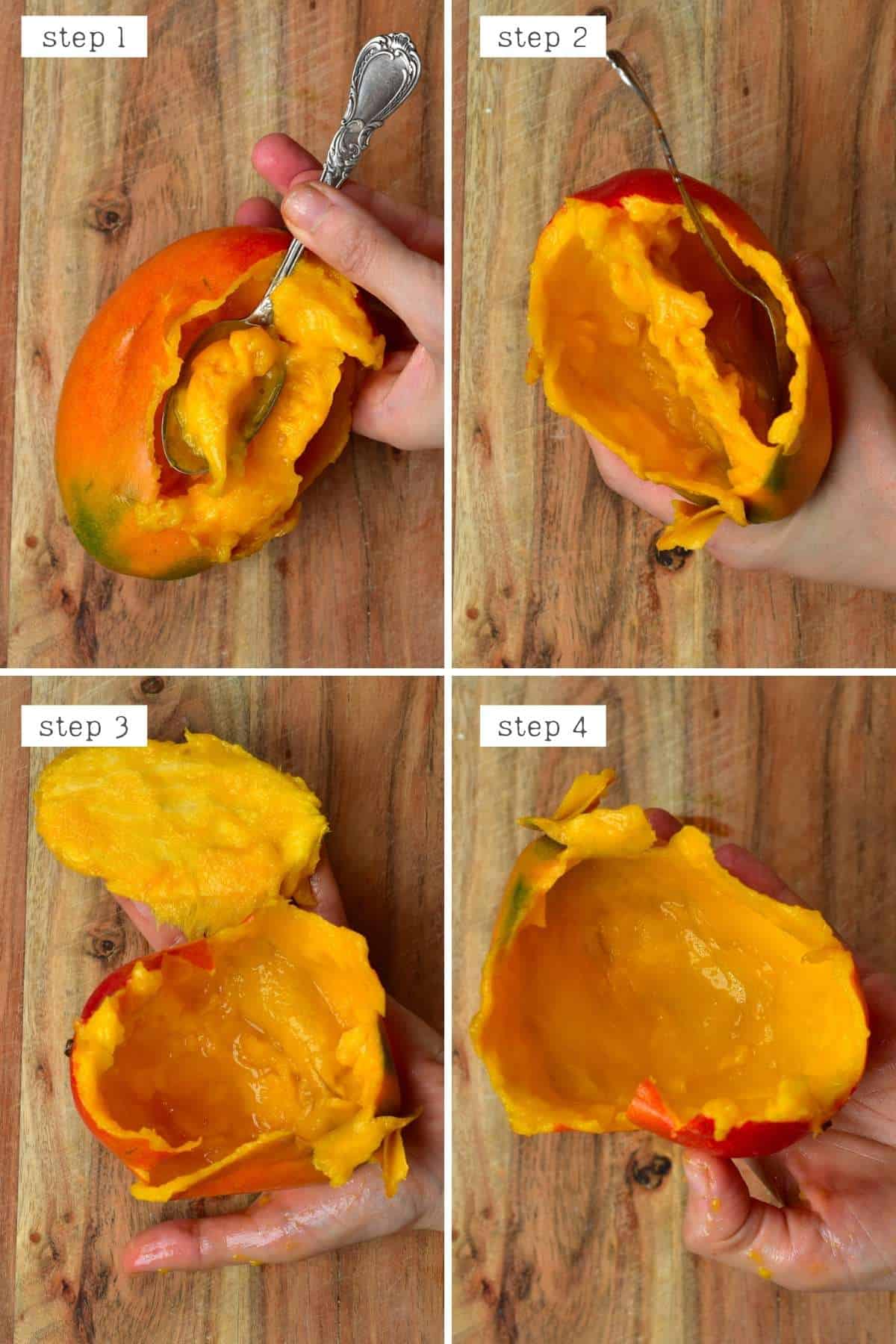
Eventually, you’ll be left with just the mango skin, which will now look a little like a “cup.”
Option 2: I know people might hate me for suggesting this, but. You can also eat a mango like an apple, peel and all. That way, you can enjoy all the extra nutrients, vitamins, fiber, and antioxidants found in the skin.
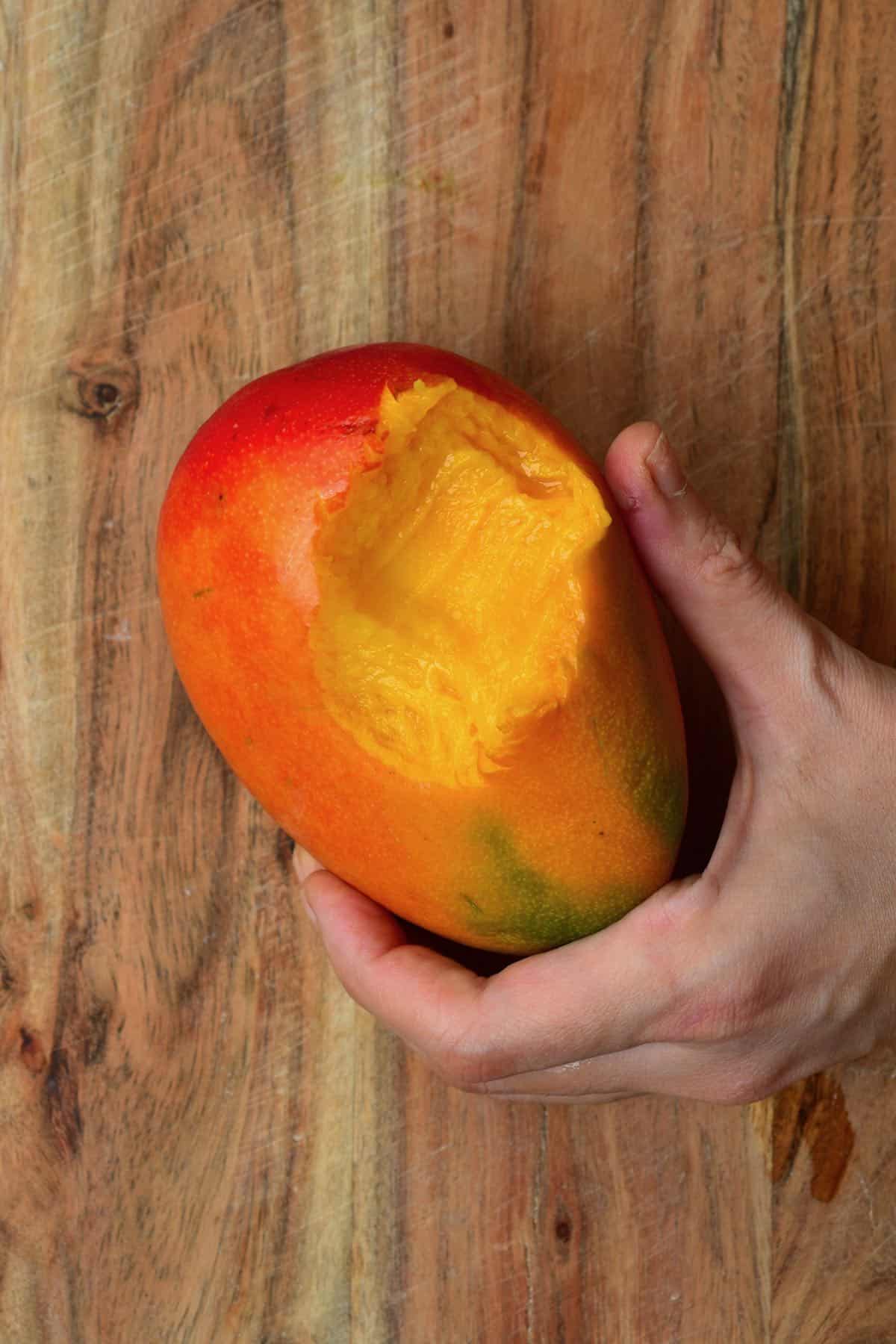
Some cultures already eat mango with the skin, and some don’t – but either way, it’s an option. Although, I should note that the skin is slightly bitter, and you must make sure to thoroughly wash the mango, too, of course.
Finally, Remove All Excess Flesh From the Pit
After using any of the methods above, you can then remove all remaining flesh from the pit section. I’ve found the easiest way to do this is to place it flat on a table and cut away the outer skin. Then, using my small sharp knife, I just cut along the sides of the mango pit to get as much remaining flesh as possible (it’s impossible to get it all).
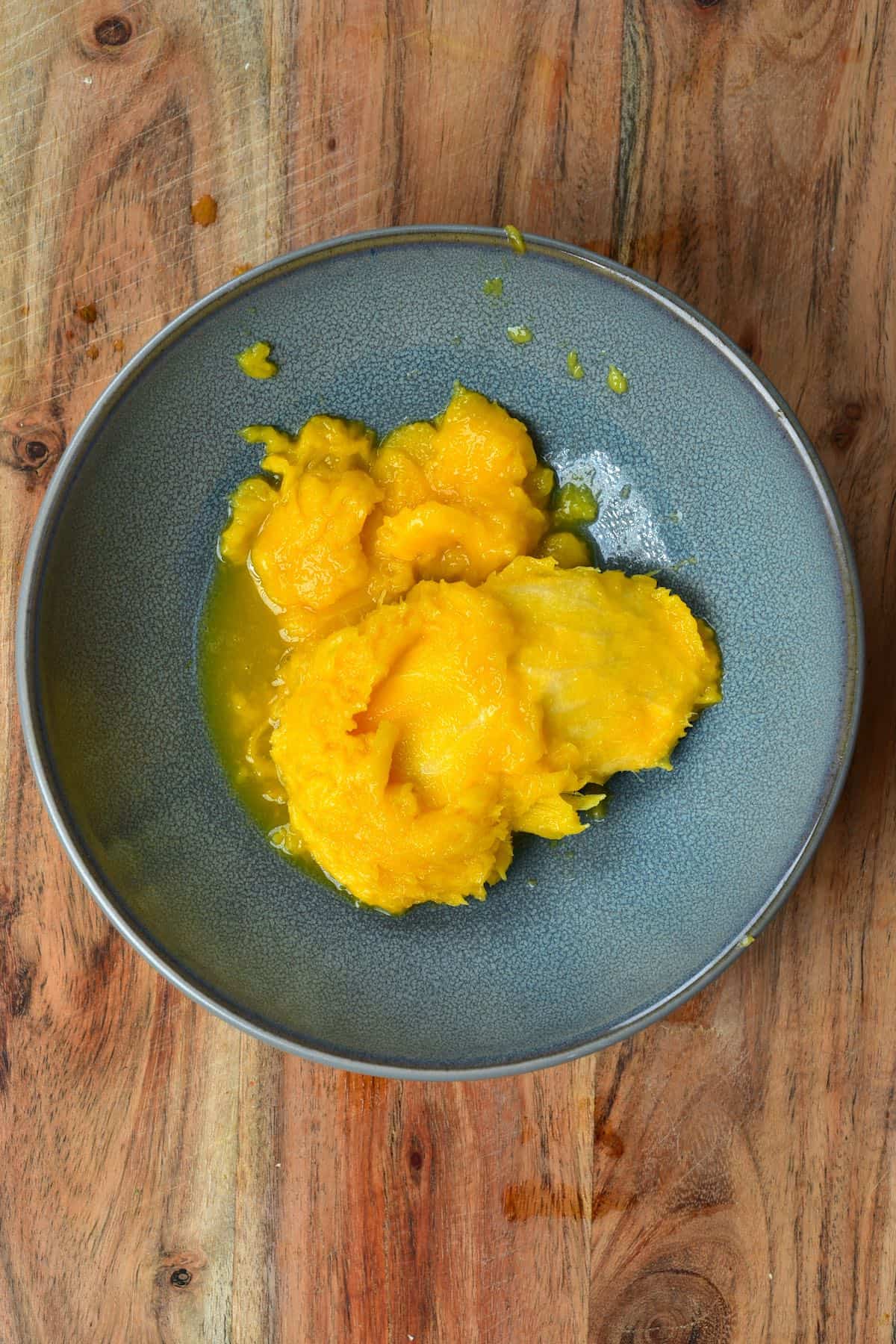
How To Store
Once chopped, mango can be kept in an airtight container in the fridge for 3-4 days. You can also freeze it for between 8-10 months (some sources say up to a year, but I’ve never had any frozen beyond six months before using it all).
So, what do you think is the best way to cut a mango? Let me know in the comments below.
How To Use
Here are just a few of the recipes containing mango on the blog that you may like.
- Tropical Mango Salad
- Mix & Match Rainbow Vegan Rice Paper Rolls
- Thai Coconut Sweet Sticky Rice
- Mango Juice (Mango Nectar)
- Tropical Mango Overnight Oats
- Raspberry & Mango Smoothie Bowl
- Citrus and Mango Smoothie Bowl
- How to Make Mango Boba (Mango Tapioca Pearls)
- How To Make Mango Lassi
- Mango Sago Dessert
- Mango Chia Pudding Bowl (with Crispy Oats and Yogurt)
Related Hacks
Ever wondered how to cut a pineapple? Check out my top ways to peel and cuy a pineapple along with this pull-apart method.
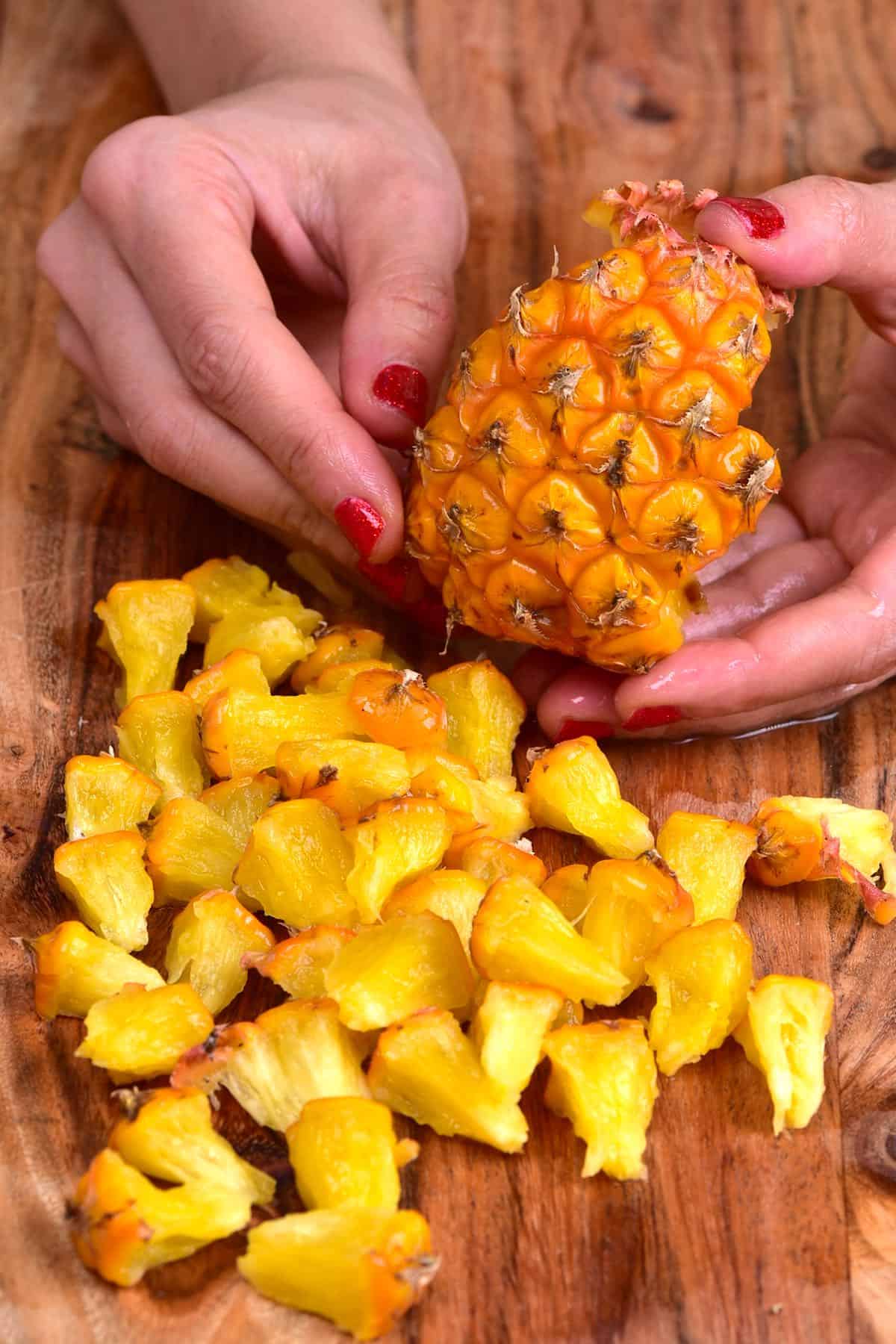
Also, feel free to tag me in your recreations @AlphaFoodie!

How to Cut a Mango (5 easy methods)
Ingredients
- 1 mango or as much as needed
Instructions
To Cut the Mango "Cheeks"
- Hold the mango with the stem facing up. The narrow, widest part of the mango is the center where the pit is. The rounder, fatter bits on each side are the "cheeks."
- Leaving around 1/2-inch from the center of the mango (where the stem is), cut straight down the mango's length, and then repeat on the other side. At this point, you should have two cheeks, and the middle part containing the pit.*
Method 1: Diced Mango
- Slice a grid pattern (the lines about 1/2-inch apart) across the flesh of both mango halves/cheek. Make sure not to cut through the skin, but as deep as you can.
- At this point, you can scoop out the flesh with a spoon OR it should be easy to push the skin side and invert the mango so that the cut sections are all sticking out (like a hedgehog).
- Use a small paring knife (or mango tool) to cut away the mango from the skin. Don't worry if you don't get it all the way to the skin as you can go back with a spoon and peel away all the remaining flesh. Do this to both "cheeks" using the knife and then a spoon to gather as much flesh as possible from the skin.
Method 2: The Glass
- This method makes peeling a ripe mango SUPER easy. But it's not for those wanting pretty mango pieces for a recipe. I'll usually use this method whenever the mango isn't going to be displayed – like smoothies, sauces, etc.
- Simply hold the bottom of one of the mango cheeks against the rim of a pint glass/glass with thin walls and slice it downwards to scoop out the flesh. It will drop into the glass and voila.If any flesh is left, with the skin then use a spoon to get it out. Your mango is ready to use.
Method 3: To Slice
- I kept this as a kind of bonus because it sort of comes under both previous methods. To cut long slices of mango then you have several options.You could cut them from the flesh removed using the glass method – but the slices won't be "pretty".
- Alternatively, you're going to need to peel the mango. Simply use a pairing knife and peel the mango before cutting it at all then you can cut off the cheeks as mentioned above and simply slice up.Be careful when slicing peeled mango though as it becomes VERY slippery.
Alternative Cutting Methods
Method 4: Cut In Half
- Like avocado (although people hate the option then, too), you can chop mango by cutting all the way around the center of the mango. When pulling, one half will have the seed in, and the other will be empty. You can then remove the seed from the other half and scoop out the flesh (or even use it as a bowl and fill the hole with yogurt (dairy or vegan – like almond, coconut, or soy) and other fruits and/or granola).
Method 5: Peel The Skin
- This is something I usually avoid, as peeled mango is very slippery. However, if you want to cut nice slices from the mango, you can peel it first before chopping the flesh away from the seed.You can peel a mango with a sharp paring knife (hold the stem while doing so), with a vegetable peeler, or by hand (which will only work if the mango is very ripe and soft.To do this, create an X in the bottom of the mango, and you should be able to pull up the sections and gently pull to remove the skin. You can also do this from the stem end.
To enjoy mango without cutting it
- Option 1: If you simply remove a small part of the skin anywhere on the ripe mango (must be ripe and soft), you can then use a small spoon to dig it and eat the mango directly from inside the skin. The more you eat, the more you scoop the flesh out from inside the skinEventually, you'll be left with just the mango skin, which will now look a little like a "cup."Option 2: I know people might hate me for suggesting this, but you can also eat a mango like an apple, peel and all. That way, you can enjoy all the extra nutrients, vitamins, fiber, and antioxidants found in the skin.Some cultures already eat mango with the skin, and some don't – but either way, it's an option. Although, I should note that the skin is slightly bitter, and you must make sure to thoroughly wash the mango, too, of course.
To Remove Remaining Flesh From The Pit
- Place it flat on a table and cut away the outer skin. Then, using a small sharp knife, just cut along the sides of the mango pit to get as much remaining flesh as possible (it's impossible to get it all).
How To Store
- Once chopped, mango can be kept in an airtight container in the fridge for 3-4 days. You can also freeze it for between 8-10 months (some sources say up to a year, but I've never had any frozen beyond six months before using it all).
Video
Notes
Nutrition
Nutrition information is automatically calculated, so should only be used as an approximation.

















I tested all your methods you shared and I prefer the one with the peeler :).
Thank you for all your tips.
Thank you for your comment and feedback, Joëlle. 🙂